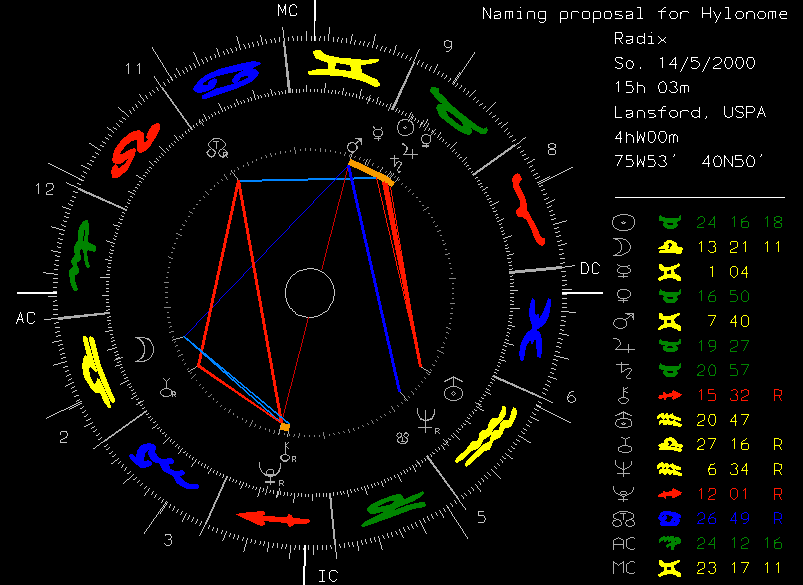
Das Benennungshoroskop für 10370 Hylonome
The naming chart for 10370 Hylonome
Entdecker: Entdeckungstabelle/ Discoverers see discovery table

10370 Hylonome is in Libra

Die Internationale Astronomische Union, Abteilung Minor Planet Center akzeptierte am 27. Juli 2000 unseren (im Mai 2000 gemachten) astrologisch und mythologisch begründeten Namensvorschlag für Hylonome im weltweit per E-Mail verschickten und auf der MPC-Homepage erhältlichem Circular/Rundschreiben über die aktuellen Positionen von
weit entfernten Kleinplaneten http://cfa-www.harvard.edu/mpec/K00/K00O24.html und der Liste der Kentauren (Minor Planet Center: List of Centaurs).
Über die Hintergründe unseres Vorschlags, die Unterstützung durch den Leiter des Kleinplanetenzentrums Dr. Brian Marsden,
die bisherige Zusammenarbeit und die Mythologie der beiden Kentauren in Kürze mehr auf der CRP-Homepage. Nach der erstmaligen astrologischen Benennung eines Kleinplaneten im Jahre 1997 (Nessus) ist dies nun das zweite Mal, dass Namensvorschläge von Astrologen aufgenommen wurden. Und weitere Vorschläge werden erwartet!
Kurz zur Mythologie: Hylonome wird nur von Ovid in seinem 12. Buch der Metamorphosen erwähnt. Dort schildert er die brutale, blutige Schlacht zwischen den Lapithen und den Kentauren, die entbrannte, als die Kentauren zur Hochzeit des Lapithenkönigs Peirithos geladen waren. Anfangs ging alles glatt, doch plötzlich versucht der Kentaur Eurythion (Eurythus) - betrunken vom Wein - die Braut Hippodameia zu entführen und zu vergewaltigen. Dies löst den Streit aus, wobei die meisten Kentauren getötet werden. Quasi als érholsames Intermezzo für den Leser erwähnt Ovid die Liebenden Cyllaros und Hylonome. Hylonome stamme aus den Wäldern, hat wunderschönes Haar, wasche sich zweimal täglich in den Flüssen und schmücke sich mit Rosmarin. Als während der Schlacht ihr Geliebter Cyllaros von einem Pfeil (oder Speer oder Schwert) verwundet wird und kurz darauf stirbt, ist sie so unglücklich, dass sie sich kurz darauf das Leben nimmt (mit dem selben Schwert).
Hier gehts zum Entdeckungshoroskop (discovery chart) von (10370) Hylonome.
A short abstract about Hylonome's mythology: She is only mentioned by Ovid in his 12th book of metamorphoses. Here he tell us the story of the cruel and gruesome battle between the Centaurs and the Lapiths, which began during a weddding of the Lapith's king Peirithos. A drunken Centaur called Eurythion tried to rape and abuse Peirthos' bride Hippodameia. This led to the terrible battle. As some sort of "intermezzo" or break Ovid wrote the story of the lovers Cyllaros and Hylonome. He describes her as a lovely and beautiful female Centaur with wonderful hair and living in the forrests. She is washing herself two times a day and has rosmary in her hair. During the battle her beloved Cyllaros was wounded by a speer or sword or arrow and died soon later. Hylonome killed herself with the same weapon, because she could not imagine to live a life without him.
We decided to propose this name for 1995 DW2 for several reasons: Hylonome has a low-eccentricity-orbit, which represents to us the more female character, so a female Centaur seems to be fitting. Furthermore DW2's-orbit is located between Neptune (Hylonome's correspondence to the rivers and self-sacrifice) and Uranus (her eccentric and sudden death). Preliminary astrological experiences are showing that her transits often occur at the time as important tunring points and landmarks manifest in our lives, often underlined by self-sacrifice-themes.